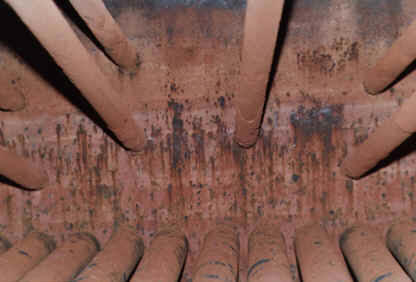|
Oxygen Corrosion
Without proper mechanical and
chemical deaeration, oxygen in the feed water enters the
boiler. Much is flashed off with the steam; the
remainder can attack boiler metal. Oxygen in water
produces pitting that is very severe because of its
localized nature. Water containing ammonia, particularly
in the presence of oxygen, readily attacks copper and
copper bearing alloys. The resulting corrosion leads to
deposits on boiler heat transfer surfaces and reduces
efficiency and reliability.
 Oxygen is highly
corrosive when present in hot water. Even small
concentrations can cause serious problems: iron oxide
generated by the corrosion can produce iron deposits in
the boiler. Oxygen corrosion may be highly localized or
may cover an extensive area. Oxygen attack is an
electrochemical process that can be described by the
following reactions: Oxygen is highly
corrosive when present in hot water. Even small
concentrations can cause serious problems: iron oxide
generated by the corrosion can produce iron deposits in
the boiler. Oxygen corrosion may be highly localized or
may cover an extensive area. Oxygen attack is an
electrochemical process that can be described by the
following reactions:
Anode:
Fe è Fe2+ + 2e-
Cathode: ½ O2 + H2O + 2e-
> 2 OH-
Overall:
Fe + ½ O2 + H2O
> Fe(OH)2
In this reaction
a temperature rise provides enough additional energy to
accelerate reactions at the metal surfaces, resulting in
a rapid and severe corrosion.
The acceptable
dissolved oxygen level for any system depends on may
factors, such as feed water temperature, pH, flow rate,
dissolved solids content, and the metallurgy and
physical condition of the system. In general, the limit
value of oxygen in make up water can be stared 0.10
mg/kg
For a complete
protection from oxygen corrosion, a chemical scavenger
is required following mechanical deaeration.
|



